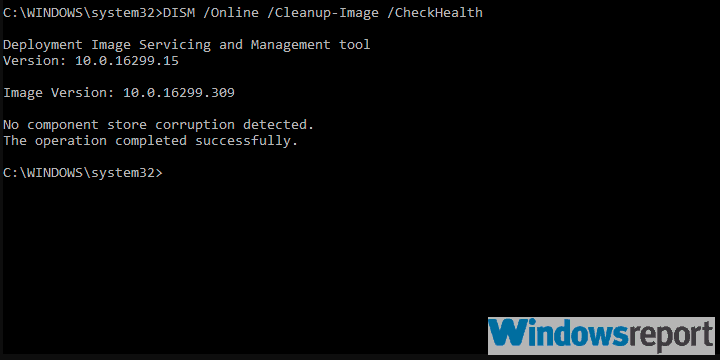Ошибка 0x803c0103 возникает при запуске средства устранения неполадок Центра обновления Windows 10. Как правило, пользователи сталкиваются с этой ошибкой в том случае, если у них не получается установить новые (или отложенные) обновления для своей системы и они решаются запустить уже упомянутое средство устранения неполадок.
Что вызывает появление ошибки 0x803c0103
Ошибка 0x803c0103 — крайне тревожная проблема, а все из-за того, что она появляется в средстве, которое должно как раз устранять эти самые проблемы. Завидев такой код перед собой и потеряв возможность обновлять свою ОС, многие пользователи впадают в панику — не нужно этого делать! Для начала нам с вами нужно понять, почему вообще возникает 0x803c0103.
- Повреждения системных файлов. Средство устранения неполадок и Центр обновления для своей работы задействуют безумное количество всевозможных системных файлов Windows 10. Если с этими файлами что-то произойдет, то есть шанс, что ни средство, ни Центр обновления не смогут корректно выполнять возложенные на них задачи. К счастью, Майкрософт не дураки — они оснастили свои ОСы специальными инструментами, которые способны восстанавливать целостность системных файлов.
- Компоненты Центра обновления находятся в «мертвой петле». В некоторых случаях службы и компоненты Центра обновления могут наглухо зависнуть, так сказать, в своеобразной мертвой петле. Открывая Центр обновления или средство устранения неполадок, система пытается получить доступ к повисшим элементам, однако ей это не удается — пользователь получает соответствующую ошибку, например, 0x803c0103.
- Банальный баг операционной системы. Бывает и такое, что средство устранения неполадок показывает вам ту или иную ошибку просто из-за того, что в Windows 10 возник какой-то странный баг, который препятствует нормальной работе некоторых компонентов ОС. Как правило, избавиться от такого бага можно с помощью элементарной перезагрузки.
Как избавиться от ошибки 0x803c0103
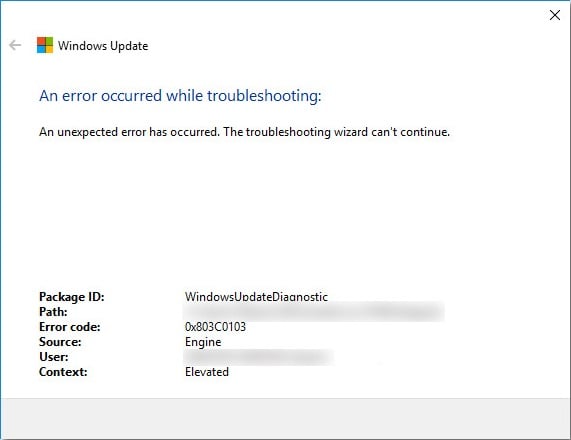
Мы настоятельно рекомендуем выполнять методы в том порядке, в котором мы указали их ниже. Поверьте, вам действительно не нужно переустанавливать свою ОС всякий раз, когда у вас не получается установить то или иное обновление для Windows 10.
Метод №1 Перезагрузка ПК
Самый простой и, на удивление, эффективный метод устранения ошибки 0x803c0103 — элементарная перезагрузка компьютера. Попробуйте перезапустить свой ПК, после чего снова запустите средство устранения неполадок и проверьте наличие ошибки. Кроме того, после перезагрузки можете сразу запустить обновление ОС: проблемы с установкой апдейтов могли разрешиться сами собой.
Метод №2 SFC и DISM — средства восстановления Windows
Средство устранения неполадок и Центр обновления могут перестать работать, если некоторые из системных файлов Windows 10 были повреждены, изменены, перемещены или удалены. Кстати, последние четыре пункта могут произойти по вине вирусов и вредоносного программного обеспечение — мы рекомендуем вам прямо сейчас запустить сканирование антивирусом. Так или иначе повреждение системных файлов необходимо как-то исправлять, верно? Тут на выручку идут такие полезные утилиты, как SFC и DISM.
Первая утилита сканирует системные файлы на наличие повреждений и устраняет последние, если это возможно, вторая — ищет повреждения в хранилище компонентов и образе системы, после чего точно также пытается их устранить. Пользоваться обеими утилитами очень и очень просто — мы покажем вам, как это сделать.
SFC для восстановления системных файлов
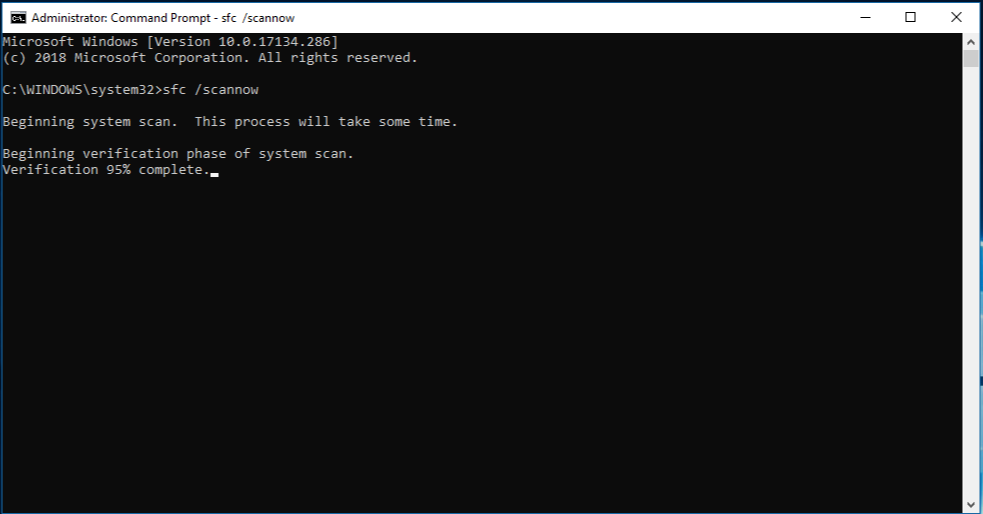
- Нажмите на клавиатуре комбинацию Win+R, чтобы открыть окошко «Выполнить».
- Вставьте в пустую поисковую строчку окна значение «CMD» (без кавычек) и нажмите комбинацию CTRL+SHIFT+ENTER.
- Открыв перед собой системную консоль (от имени администратора), вставьте в нее команду «sfc /scannow» (без кавычек) и нажмите ENTER.
- Подождите несколько минут (или дольше), ознакомьтесь с результатами работы утилиты и перезагрузите компьютер.
DISM для восстановления хранилища компонентов и образа системы
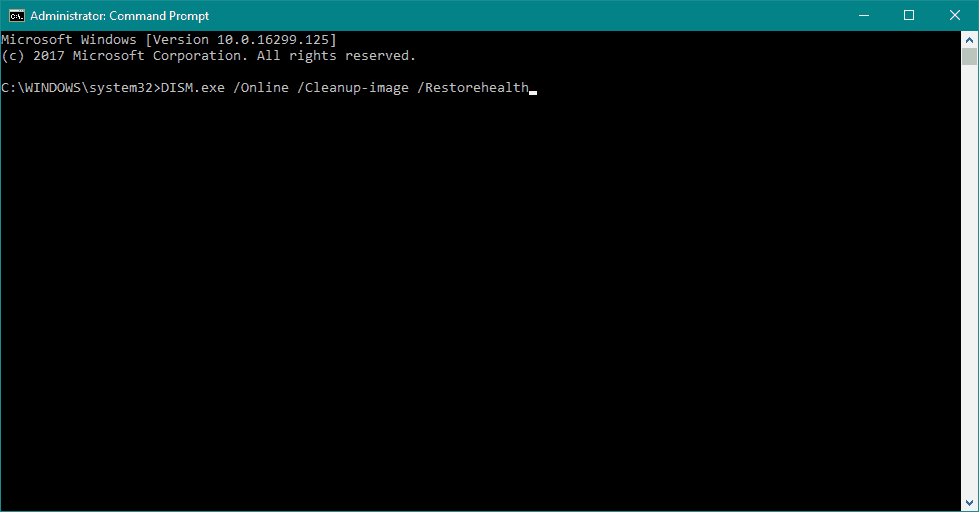
- Нажмите на клавиатуре комбинацию Win+R, чтобы открыть окошко «Выполнить».
- Вставьте в пустую поисковую строчку окна значение «CMD» (без кавычек) и нажмите комбинацию CTRL+SHIFT+ENTER.
- Открыв перед собой системную консоль (от имени администратора), вставьте в нее команду «Dism /Online /Cleanup-Image /CheckHealth» и нажмите ENTER.
- Ознакомьтесь с результатами проверки, после чего вставьте в консоль команду «Dism /Online /Cleanup-Image /ScanHealth» и нажмите ENTER.
- Снова ознакомьтесь с результатами сканирования, затем вставьте команду «Dism /Online /Cleanup-Image /RestoreHealth» и нажмите ENTER.
- Подождите завершения восстановления и перезагрузите ПК.
Важно отметить, что для выполнения некоторых из указанных выше команд может потребоваться достаточно большое количество времени. Проще говоря, вам, возможно, придется набраться терпения. Как только закончите работать с SFC и DISM, проверьте, была ли устранена ошибка 0x803c0103 в средстве устранения неполадок и исчезли ли проблемы в Центре обновления Windows 10.
Метод №3 Запуск точки восстановления системы
Раньше ни со средством устранения неполадок, ни с Центром обновления не возникало никаких проблем? Тогда, возможно, вы имеете дело с конфликтом, который возник между системными компонентами Windows 10 и сторонним программным обеспечением. Рекомендуем воспользоваться точкой восстановления, чтобы вернуть свою систему к более стабильному состоянию.
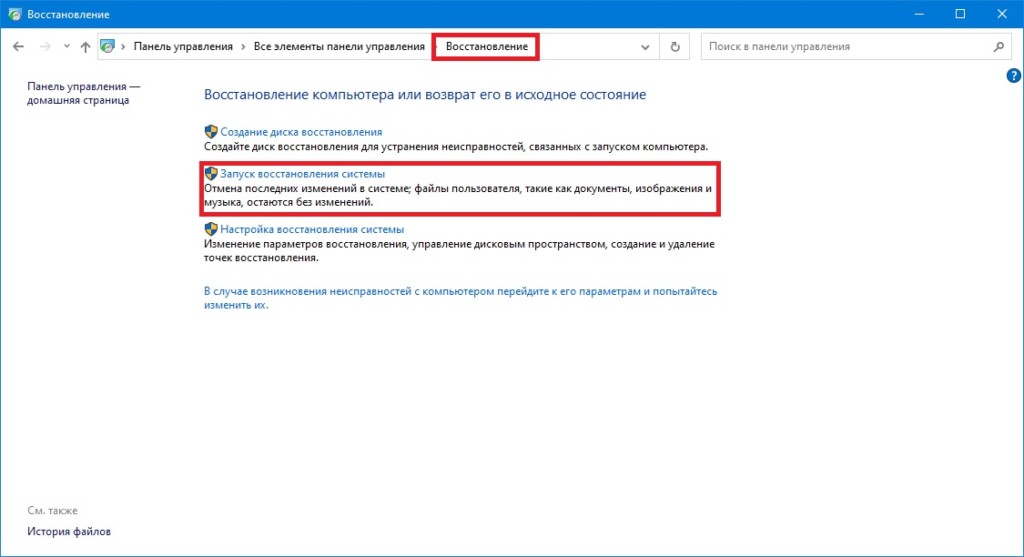
- Нажмите Win+R для вызова окошка «Выполнить».
- Пропишите в пустой строке значение «control» и нажмите ENTER.
- Измените режим просмотра на «Крупные значки».
- Перейдите в Панели управлении в раздел «Восстановление».
- Кликните на пункт «Запуск восстановления системы».
- Теперь нажмите на кнопку «Далее», выберите подходящую точку восстановления и нажмите еще раз «Далее».
- И наконец-то, нажмите на кнопку «Готово», чтобы начать восстановления системы.
Важно отметить, что во время восстановления ОС ваш компьютер автоматически перезагрузится. Как только зайдете в систему, проверьте наличие ошибки 0x803c0103.
Метод №4 Починка компонентов Центра обновления
Неполадки в средстве устранения неполадок и самом Центре обновления могли быть вызваны некорректной работой тех или иных компонентов этого самого Центра обновления. Решается такая проблема с помощью сброса компонентов ЦО. Сброс компонентов ЦО Windows 10 — это достаточно простой процесс, несмотря на заявления некоторых пользователей в сети.
Осуществить подобный сброс можно как вручную, так и в полуавтоматическом режиме. Мы рекомендуем вам не тратить свое время, и воспользоваться вторым вариантом.
Полуавтоматический сброс компонентов Центра обновления
- Создайте на своей Рабочем столе (или любом другом удобном вам месте) самый обычный текстовый файл. Не знаете, как это сделать? Нажмите ПКМ на пустое место и выберите пункты «Создать→Текстовый документ».
- Откройте созданный файл и вставьте в него следующий скрипт:
:: Run the reset Windows Update components.
:: void components();
:: /*************************************************************************************/
:components
:: —— Stopping the Windows Update services ——
call :print Stopping the Windows Update services.
net stop bitscall :print Stopping the Windows Update services.
net stop wuauservcall :print Stopping the Windows Update services.
net stop appidsvccall :print Stopping the Windows Update services.
net stop cryptsvccall :print Canceling the Windows Update process.
taskkill /im wuauclt.exe /f
:: —— Checking the services status ——
call :print Checking the services status.sc query bits | findstr /I /C:»STOPPED»
if %errorlevel% NEQ 0 (
echo. Failed to stop the BITS service.
echo.
echo.Press any key to continue . . .
pause>nul
goto :eof
)call :print Checking the services status.sc query wuauserv | findstr /I /C:»STOPPED»
if %errorlevel% NEQ 0 (
echo. Failed to stop the Windows Update service.
echo.
echo.Press any key to continue . . .
pause>nul
goto :eof
)call :print Checking the services status.sc query appidsvc | findstr /I /C:»STOPPED»
if %errorlevel% NEQ 0 (
sc query appidsvc | findstr /I /C:»OpenService FAILED 1060″
if %errorlevel% NEQ 0 (
echo. Failed to stop the Application Identity service.
echo.
echo.Press any key to continue . . .
pause>nul
if %family% NEQ 6 goto :eof
)
)
call :print Checking the services status.sc query cryptsvc | findstr /I /C:»STOPPED»
if %errorlevel% NEQ 0 (
echo. Failed to stop the Cryptographic Services service.
echo.
echo.Press any key to continue . . .
pause>nul
goto :eof
):: —— Delete the qmgr*.dat files ——
call :print Deleting the qmgr*.dat files.
del /s /q /f «%ALLUSERSPROFILE%\Microsoft\Network\Downloader\qmgr*.dat»
call :print Deleting the old software distribution backup copies.
del /s /q /f «%SYSTEMROOT%\winsxs\pending.xml.bak»
)
if exist «%SYSTEMROOT%\SoftwareDistribution.bak» (
rmdir /s /q «%SYSTEMROOT%\SoftwareDistribution.bak»
)
if exist «%SYSTEMROOT%\system32\Catroot2.bak» (
rmdir /s /q «%SYSTEMROOT%\system32\Catroot2.bak»
)
if exist «%SYSTEMROOT%\WindowsUpdate.log.bak» (
del /s /q /f «%SYSTEMROOT%\WindowsUpdate.log.bak»
)
takeown /f «%SYSTEMROOT%\winsxs\pending.xml»
attrib -r -s -h /s /d «%SYSTEMROOT%\winsxs\pending.xml»
ren «%SYSTEMROOT%\winsxs\pending.xml» pending.xml.bak
)
if exist «%SYSTEMROOT%\SoftwareDistribution» (
attrib -r -s -h /s /d «%SYSTEMROOT%\SoftwareDistribution»
ren «%SYSTEMROOT%\SoftwareDistribution» SoftwareDistribution.bak
if exist «%SYSTEMROOT%\SoftwareDistribution» (
echo.
echo. Failed to rename the SoftwareDistribution folder.
echo.
echo.Press any key to continue . . .
pause>nul
goto :eof
)
)
if exist «%SYSTEMROOT%\system32\Catroot2» (
attrib -r -s -h /s /d «%SYSTEMROOT%\system32\Catroot2»
ren «%SYSTEMROOT%\system32\Catroot2» Catroot2.bak
)
if exist «%SYSTEMROOT%\WindowsUpdate.log» (
attrib -r -s -h /s /d «%SYSTEMROOT%\WindowsUpdate.log»
ren «%SYSTEMROOT%\WindowsUpdate.log» WindowsUpdate.log.bak
)
call :print Reset the BITS service and the Windows Update service to the default security descriptor.
sc.exe sdset bits D:(A;;CCLCSWLOCRRC;;;AU)(A;;CCDCLCSWRPWPDTLOCRSDRCWDWO;;;BA)(A;;CCDCLCSWRPWPDTLCRSDRCWDWO;;;SO)(A;;CCLCSWRPWPDTLOCRRC;;;SY)S:(AU;FA;CCDCLCSWRPWPDTLOCRSDRCWDWO;;WD)
sc.exe sdset cryptsvc D:(A;;CCLCSWLOCRRC;;;AU)(A;;CCDCLCSWRPWPDTLOCRSDRCWDWO;;;BA)(A;;CCDCLCSWRPWPDTLCRSDRCWDWO;;;SO)(A;;CCLCSWRPWPDTLOCRRC;;;SY)S:(AU;FA;CCDCLCSWRPWPDTLOCRSDRCWDWO;;WD)
sc.exe sdset trustedinstaller D:(A;;CCLCSWLOCRRC;;;AU)(A;;CCDCLCSWRPWPDTLOCRSDRCWDWO;;;BA)(A;;CCDCLCSWRPWPDTLCRSDRCWDWO;;;SO)(A;;CCLCSWRPWPDTLOCRRC;;;SY)S:(AU;FA;CCDCLCSWRPWPDTLOCRSDRCWDWO;;WD)
call :print Reregister the BITS files and the Windows Update files.
regsvr32.exe /s atl.dll
regsvr32.exe /s urlmon.dll
regsvr32.exe /s mshtml.dll
regsvr32.exe /s shdocvw.dll
regsvr32.exe /s browseui.dll
regsvr32.exe /s jscript.dll
regsvr32.exe /s vbscript.dll
regsvr32.exe /s scrrun.dll
regsvr32.exe /s msxml.dll
regsvr32.exe /s msxml3.dll
regsvr32.exe /s msxml6.dll
regsvr32.exe /s actxprxy.dll
regsvr32.exe /s softpub.dll
regsvr32.exe /s wintrust.dll
regsvr32.exe /s dssenh.dll
regsvr32.exe /s rsaenh.dll
regsvr32.exe /s gpkcsp.dll
regsvr32.exe /s sccbase.dll
regsvr32.exe /s slbcsp.dll
regsvr32.exe /s cryptdlg.dll
regsvr32.exe /s oleaut32.dll
regsvr32.exe /s ole32.dll
regsvr32.exe /s shell32.dll
regsvr32.exe /s initpki.dll
regsvr32.exe /s wuapi.dll
regsvr32.exe /s wuaueng.dll
regsvr32.exe /s wuaueng1.dll
regsvr32.exe /s wucltui.dll
regsvr32.exe /s wups.dll
regsvr32.exe /s wups2.dll
regsvr32.exe /s wuweb.dll
regsvr32.exe /s qmgr.dll
regsvr32.exe /s qmgrprxy.dll
regsvr32.exe /s wucltux.dll
regsvr32.exe /s muweb.dll
regsvr32.exe /s wuwebv.dll
call :print Resetting Winsock.
netsh winsock reset
call :print Resetting WinHTTP Proxy.
proxycfg.exe -d
) else (
netsh winhttp reset proxy
)
call :print Resetting the services as automatics.
sc.exe config wuauserv start= auto
sc.exe config bits start= delayed-auto
sc.exe config cryptsvc start= auto
sc.exe config TrustedInstaller start= demand
sc.exe config DcomLaunch start= auto
call :print Starting the Windows Update services.
net start bits
net start wuauserv
net start appidsvc
net start cryptsvc
net start DcomLaunch
call :print The operation completed successfully.
pause>nul
goto :eof
:: /*************************************************************************************/ - Нажмите на пункт «Файл» в строке меню окна Блокнота и выберите «Сохранить как…».
- Выберите удобное для вас расположение, например, Рабочий стол или системный раздел диска.
- Задайте файлу имя «Сброс_компонентов_Центра_обновления» и расширение «.bat».
Заметка: активируйте параметр «Расширения имен файлов» в настройках Проводника Windows 10 (вкладка «Вид»).
- Кликните кнопку «Сохранить», когда все будет готово.
- Нажмите на созданный файл «Сброс_компонентов_Центра_обновления.bat» ПКМ и выберите «Запуск от имени администратора».
- Подождите завершения процесса сброса компонентов Центра обновления, после чего ваш ПК будет перезагружен автоматически.
Ручной сброс компонентов Центра обновления
Если по какой-то причине скрипт выше не сработал на вашем компьютере, то вы всегда можете сбросить компоненты ЦО своими силами. Данный процесс может занять у вас какое-то время, а поэтому убедитесь, что вам никто и ничто не будет мешать.
- Нажмите ПКМ на Пуск и выберите «Командная строка (администратор)».
- Поочередно вводите все нижеуказанные команды, нажимая ENTER после каждой из них:
- net stop bits
- net stop wuauserv
- net stop cryptsvc
- Del «%ALLUSERSPROFILE%\Application Data\Microsoft\Network\Downloader\qmgr*.dat»
- Ren %Systemroot%\SoftwareDistribution\DataStore DataStore.bak
- Ren %Systemroot%\SoftwareDistribution\Download Download.bak
- Ren %Systemroot%\System32\catroot2 catroot2.bak
- sc.exe sdset bits D:(A;;CCLCSWRPWPDTLOCRRC;;;SY)(A;;CCDCLCSWRPWPDTLOCRSDRCWDWO;;;BA)(A;;CCLCSWLOCRRC;;;AU)(A;;CCLCSWRPWPDTLOCRRC;;;PU)
- sc.exe sdset wuauserv D:(A;;CCLCSWRPWPDTLOCRRC;;;SY)(A;;CCDCLCSWRPWPDTLOCRSDRCWDWO;;;BA)(A;;CCLCSWLOCRRC;;;AU)(A;;CCLCSWRPWPDTLOCRRC;;;PU)
- cd /d %windir%\system32
- regsvr32.exe atl.dll
- regsvr32.exe urlmon.dll
- regsvr32.exe mshtml.dll
- regsvr32.exe shdocvw.dll
- regsvr32.exe browseui.dll
- regsvr32.exe jscript.dll
- regsvr32.exe vbscript.dll
- regsvr32.exe scrrun.dll
- regsvr32.exe msxml.dll
- regsvr32.exe msxml3.dll
- regsvr32.exe msxml6.dll
- regsvr32.exe actxprxy.dll
- regsvr32.exe softpub.dll
- regsvr32.exe wintrust.dll
- regsvr32.exe dssenh.dll
- regsvr32.exe rsaenh.dll
- regsvr32.exe gpkcsp.dll
- regsvr32.exe sccbase.dll
- regsvr32.exe slbcsp.dll
- regsvr32.exe cryptdlg.dll
- regsvr32.exe oleaut32.dll
- regsvr32.exe ole32.dll
- regsvr32.exe shell32.dll
- regsvr32.exe initpki.dll
- regsvr32.exe wuapi.dll
- regsvr32.exe wuaueng.dll
- regsvr32.exe wuaueng1.dll
- regsvr32.exe wucltui.dll
- regsvr32.exe wups.dll
- regsvr32.exe wups2.dll
- regsvr32.exe wuweb.dll
- regsvr32.exe qmgr.dll
- regsvr32.exe qmgrprxy.dll
- regsvr32.exe wucltux.dll
- regsvr32.exe muweb.dll
- regsvr32.exe wuwebv.dll
- netsh winsock reset
- net start bits
- net start wuauserv
- net start cryptsvc
- Закончив вводить команды, перезагрузите ПК.
Войдя в систему, попробуйте обновить свою Windows 10. Если у вас снова возникли проблемы, то откройте средство устранения неполадок и проверьте наличие ошибки 0x803c0103.
Метод №5 Возвращение ПК в исходное состояние (+ альтернативные решения)
Бывает и такое, что все вышеуказанные методы окажутся бесполезными — что же делать в таком случае? По правде говоря, у вас осталось не то что бы много вариантов. Во-первых, вы можете собственноручно установить проблемное обновление, воспользовавшись услугами каталога Центра обновления Майкрософт. Во-вторых, вы можете пропустить установку определенного обновления в Центре обновления.
Ну и в третьих, вы можете запустить возвращение ПК к исходному состоянию, что, по сути, является своеобразной переустановкой Windows 10 без потери личных данных (тут по выбору). Итак, вот что вам нужно сделать:
- Нажмите на клавиатуре комбинацию Win+I, чтобы открыть окошко «Параметры».
- Перейдите в раздел «Обновление и безопасность», потом — в подраздел «Восстановление».
- Кликните на кнопку «Начать» под пунктом «Вернуть компьютер в исходное состояние».
- Выберите пункт «Сохранить мои файлы» и следуйте дальнейшим инструкциям на экране.
Внимание: ваш ПК будет автоматически перезагружен в процессе восстановления. Как только войдете в систему, проверьте, были ли решены проблемы с Центром обновления, а также исчезла ли ошибка 0x803c0103 из средства устранения неполадок.
When running Windows update troubleshooter, you may encounter the error code 0x8030c0103. Then what may cause the Windows 10 update error code 0x803c0103? What are the 0x803c0103 fixes? This post from MiniTool will show you the solutions.
What Causes the Windows 10 Troubleshooter Error 0x803c0103?
Some computer users complain that they failed to update Windows 10 and they receive an error while troubleshooting. The error always comes with the code 0x803c0103. Here is a real example.
Cannot receive updates – Microsoft or others. Followed advice and tried to use troubleshooter for updates. It stopped with the following error code 0x803C0103. Help! From answers.microsoft.com
In general, when coming across the error code 0x803c0103, it means that the Windows 10 update is failed. In addition, the Windows 10 update error code 0x803c0103 may be caused by the damaged or misconfigured Windows system files which could bring a risk to your computer.
So, in the following section, we will show you how to fix this Windows update troubleshooter 0x803c0103 error so as to update Windows to the latest version successfully.
6 Ways to Fix the Windows 10 Troubleshooter Error Code 0x803c0103
Solution 1. Run SFC and DISM Tools
As we have mentioned in the above part, the corrupted system files will lead to Windows update failure such as encountering the Windows update troubleshooter 0x803c0103 error. So, in order to fix this Windows update error, scan and fix the corrupted system files first.
Now, here is the tutorial.
Step 1: Type the Command Prompt in the search box of Windows and choose the best-matched one. Right-click it and choose Run as administrator to continue.
Step 2: In the pop-up window, type the command sfc /scannow and hit Enter to continue.
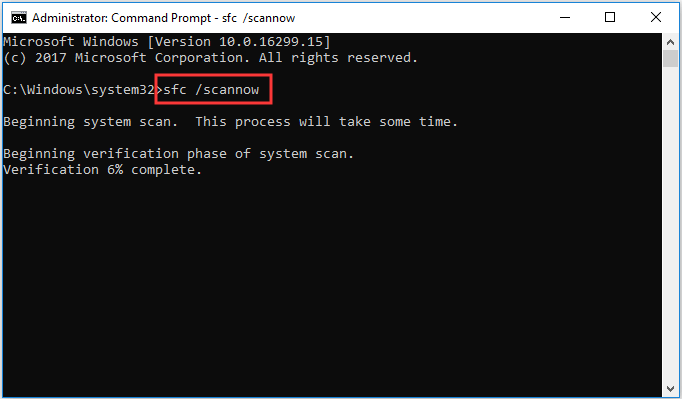
Step 3: Please do not close the command line window until you see the message verification 100% completed.
After that, reboot your computer and run Windows update again and check whether the Windows 10 update error code 0x803c0103 is solved.
If the sfc scannow command does not work, you can run the DISM tool to scan and fix the corrupted files again.
Step 4: Then type the following commands and hit Enter to continue.
DISM /online /Cleanup-Image / ScanHealth
DISM /Online /Cleanup-Image /RestoreHealth
When it is finished, reboot your computer and run Windows update again to check whether the 0x803c0103 Windows 10 is solved.
If this solution is not effective, you can try other solutions.
Solution 2. Download Another Windows Update Troubleshooter
The error code 0x803c0103 occurs when you are running Windows update troubleshooter. So, in order to fix it, you can choose to download another Windows update troubleshooter from the Microsoft.
Now, we will show you the tutorial.
Step 1: Click here to download the Windows update troubleshooter. You can choose to download anyone according to your current Windows version.
Step 2: Then run it on your computer. Select Windows Update and click Next to continue.
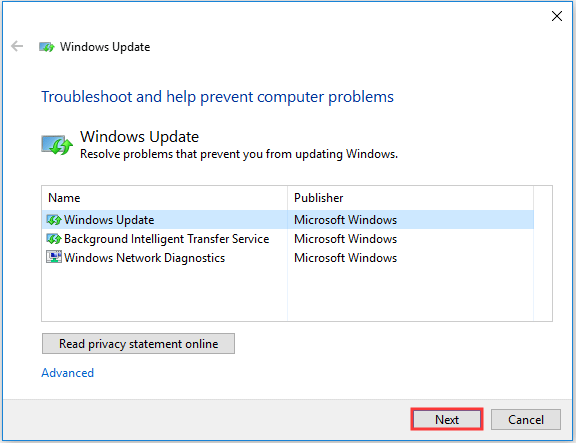
Step 3: Next, Windows Update troubleshooter will begin to detect the problem on your computer. And then click Try troubleshooting as an administrator to continue.

Next, you can follow the instructions to go on. When it is finished, you can check whether the Windows update troubleshooter error 0x803c0103 still occurs.
If this solution doesn’t take effect, try the following solutions.
Solution 3. Scan the Virus on Your Computer
The Windows update error 0x803c0103 may also be caused by the virus. On the other hand, the virus on your computer may lead to damaged system files. Hence, in order to fix the Windows 10 update error code 0x803c0103, you can check the virus on your computer.
To check the virus on your computer, you can use the Windows built-in tool – Windows Defender or the third-party antivirus software, such as the Avast.
In this post, we will show you how to use the Windows Defender to scan and remove the virus on your computer.
Now, here is the tutorial.
Step 1: Press Windows key and I key together to open Settings. After entering its main interface, choose Update & Security to continue.
Step 2: Then click Windows Defender tab on the left panel and choose Open Windows Defender Security Center to continue.
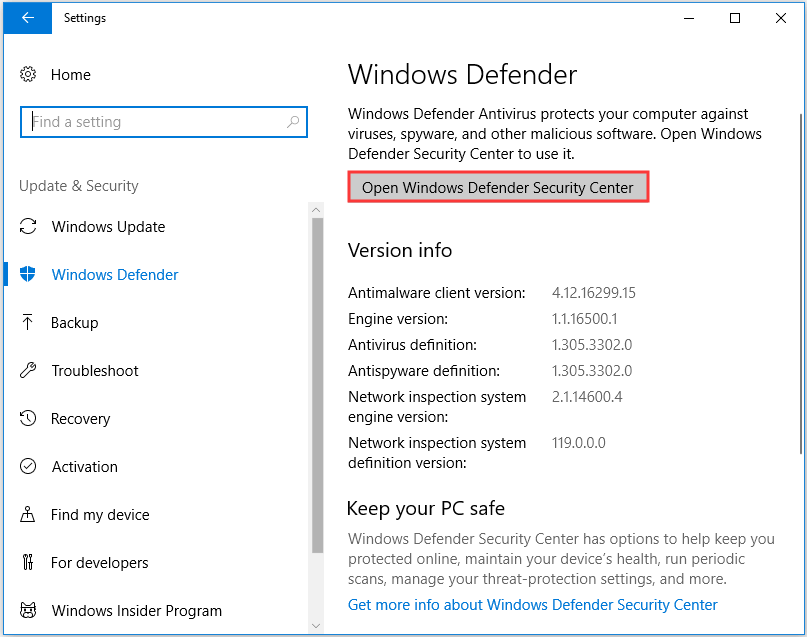
Step 3: Then choose Virus & threat protection to continue.
Step 4: In the pop-up window, click Quick scan to continue.
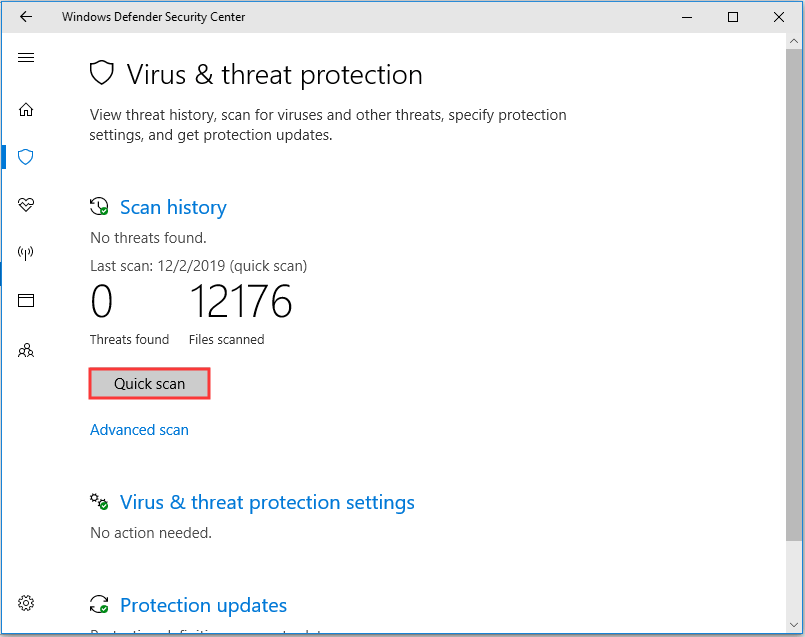
After the scanning process is finished, reboot your computer and run Windows update again and check whether the error code 0x803c0103 is solved.
Solution 4. Reset Windows Update Component
If the above solutions cannot fix the error 0x803c0103 Windows 10, you can try resetting Windows update components. Resetting Windows update components may solve some internal problems.
Now, here is the tutorial.
Step 1: Type Command Prompt in the search box of Windows and choose the best-matched one. Then right-click it to choose Run as administrator to continue.
Step 2: In the pop-up window, type the following commands and hit Enter to continue after each command.
- net stop wuauserv
- net stop bits
- net stop cryptsvc
- ren C:WindowsSoftwareDistribution SoftwareDistribution.old
- ren C:WindowsSystem32catroot2 Catroot2.old
- net start wuauserv
- net start bits
- net start cryptsvc
When the process is finished, reboot your computer and run Windows update again to check whether the error code 0x803c0103 is solved.
If this solution doesn’t take effect, you can go on the following methods.
Solution 5. Perform a System Restore
This is another available solution for you to fix the Windows update troubleshooter 0x803c0103 error. In this solution, you can perform a system restore. But the precondition to perform a system restore is that you have created a restore point before.
So, if there is no previously created restore point on your computer, you need to try other solutions.
Now, here is the tutorial.
Step 1: Type create a restore point in the search box of Windows and choose the best-matched one. Then click it to enter its main interface.
Step 2: In the System Protection tab, click System Restore… to continue.
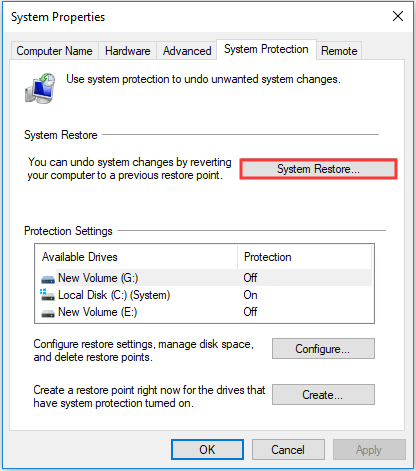
Step 3: Then click Next to continue.
Step 4: Select one restore point and choose Next to continue. If there are too many restore points, you can choose it according to the creating time.

Step 5: At last, confirm the restore settings and click Finish to continue. Please note that do not interrupt the restore process until it is finished. Otherwise, the restore process will fail.
When the system restore process is finished, reboot your computer and check whether the error code 0x803c0103 is solved.
Apart from the system restore points, if you can also restore your computer to a previous state with the system image created before.
Solution 6. Reset the Computer
If all the above solutions do not work, resetting the computer is a choice. In general, resetting the computer is able to solve almost system problems. So, if none of the solutions can fix the error code 0x803c0103, you can choose to reset the computer. However, before going ahead, please back up all your important files so as to avoid data loss.
Now, we will show you how to reset your computer.
Step 1: Press Windows key and I key together to open Settings. Then choose Update & Security to continue.
Step 2: In the pop-up window, click Recovery, and choose Restart now under Advanced startup to continue.
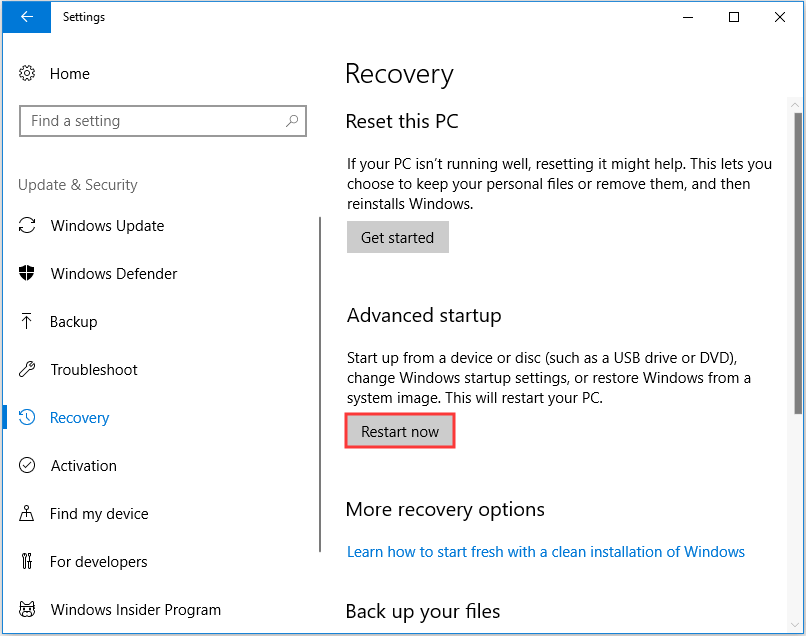
Step 3: Then you will enter the Windows Recovery Environment. Click Troubleshoot > Reset this PC to continue.
Step 4: Next, you can choose to keep your files or remove everything on PC. It is recommended to choose to Keep my files.

After that, follow the instruction to continue. When the resetting is finished, the error code 0x803c0103 will be removed from your computer.
Besides resetting the PC, you can also choose to reinstall the operating system.
After resolving the Windows 10 update error 0x803c0103, is it finished? Of course not, you can keep on your reading to find more Windows tips.
I encountered the error code 0x803c0103 and asked for help on the Internet. Thanks to this post. I successfully solved this error and I’d like to share it with more friends. Click to Tweet
What to Do After Solving Error Code 0x803c0103?
After fixing the error code 0x803c0103, what should you do? It is recommended to create a system image. Meanwhile, you may ask why you should create a system image. As a matter of fact, there are several advantages to do that.
- First, you can restore your computer to a normal state when encountering problems such as Windows 10 update error code 0x803c0103 with the created system image. Restore your computer to a normal state directly can save a lot of time.
- Second, creating a system image is an effective way to safeguard your computer and files.
Hence, with so many advantages, it is strongly suggested that you create a system image now. To create a system image, you can use the professional backup software – MiniTool ShadowMaker.
MiniTool ShadowMaker enables you to back up files, folders, disks, partitions, and the operating system. It also enables you to clone OS from HDD to SSD.
So, download MiniTool ShadowMaker Trial from the following button or choose to purchase an advanced edition.
MiniTool ShadowMaker TrialClick to Download100%Clean & Safe
Now, we will show you how to create a system image with the professional backup software.
Step 1: Download MiniTool ShadowMaker, install and launch it. Click Keep Trial, and click Connect in This Computer to enter its main interface.
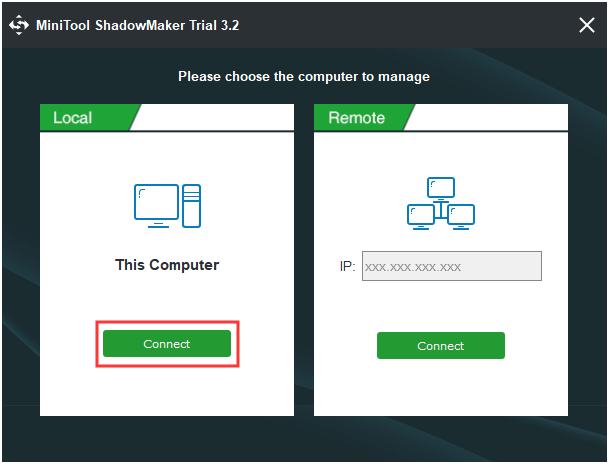
Step 2: After entering its main interface, go to the Backup page. MiniTool ShadowMaker is designed to back up the operating system, so it chooses the OS as the backup source by default. If you want to change backup source, click Source module to continue.
Step 3: Click Destination module to choose the backup destination. Here are four available paths including Administrator, Libraries, Hard drives and the Shared folder. It is recommended to choose the external hard drive as the backup source.
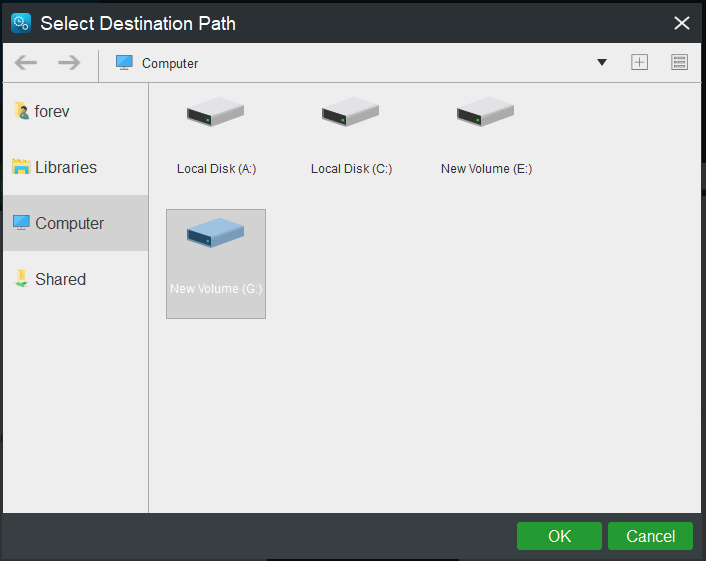
Step 4: After selecting the backup source and destination, you can perform the backup task immediately. Click Back up Now to continue.
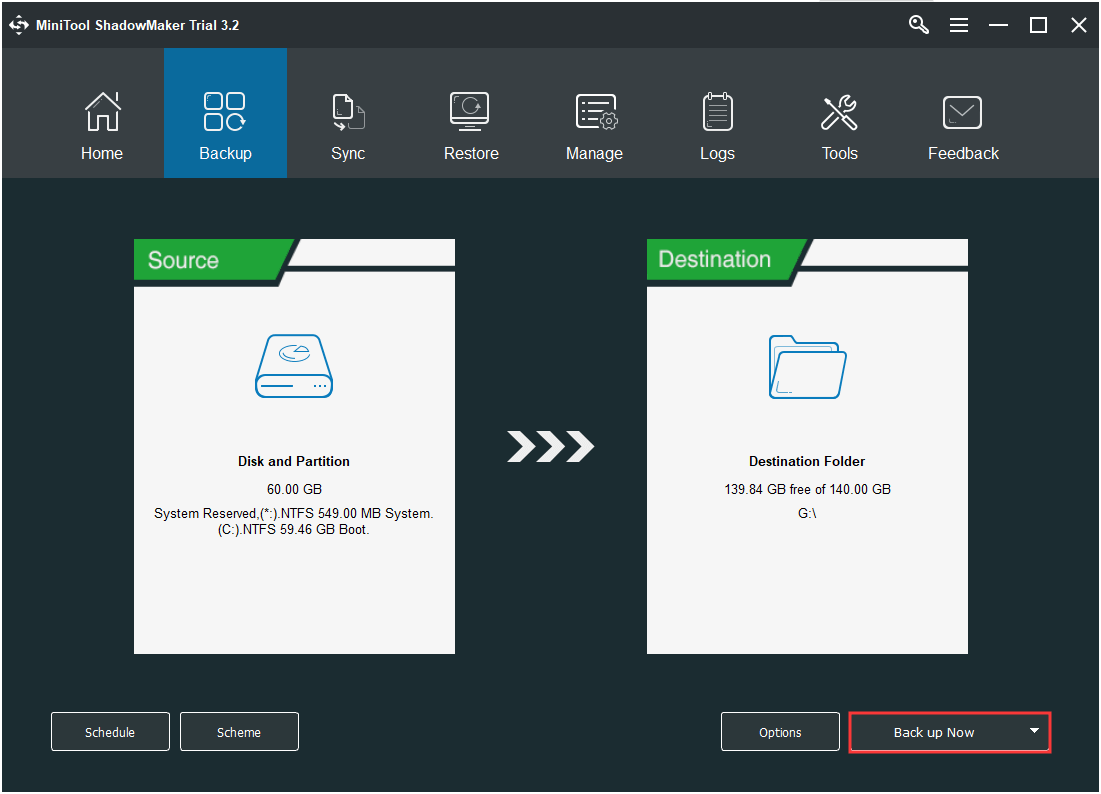
When the backup process is finished, the system image is successfully created. When you encounter the Windows update troubleshooter 0x803c0103 error again or some other system errors, use the system image to restore your computer to a normal state directly.
So, creating a system image would be a great and effective way to safeguard your computer and files.
MiniTool ShadowMaker TrialClick to Download100%Clean & Safe
Bottom Line
In conclusion, this post has introduced what the error code 0x803c0103 is and how to fix this Windows update error with 6 solutions. If you encountered the same error, try these solutions.
If you have any better solution to fix this Windows 10 Windows update diagnostic error code 0x803c0103, you can share it in the comment zone.
If you have any problem with MiniTool ShadowMaker, please feel free to contact us via the email [email protected] and we will apply to you as soon as possible.
Readers help support Windows Report. We may get a commission if you buy through our links.
Read our disclosure page to find out how can you help Windows Report sustain the editorial team. Read more
Windows 10 Updates are occasionally quite troublesome. There are dozens of different update-related errors plaguing users from day one.
And, since updates are mandatory in Windows 10, chances are you’ll run into one of the errors sooner or later. After the error occurs, most users will reach for the built-in troubleshooter.
However, there seems to be an error with the Update Troubleshooter itself and it goes by the 0x803c0103 code.
If this or similar errors bother you while running the Update Troubleshooter, make sure to try the steps below in order to resolve it.
How can I fix update error 0x803c0103?
1. Run SFC and DISM
Let’s start with the usual solution whenever any system tool fails to deliver. If some of the essential Windows files are corrupted, chances are that certain built-in features will get broken.
This isn’t uncommon for Windows Update for Windows 10, which tends to break PCs left and right. Users who experienced the update error and then tried running the troubleshooter, have tasted this first hand.
When something like this happens, we need to check the system for corruption. Whether the last unoptimized update brought this upon you, or it’s something else at hand – it doesn’t matter.
What matters is that you have all the tools you need to fix it right there. The first tool is the System File Checker, which scans and resolves system corruption.
The other one takes the same task to another level and it’s called Deployment Image Servicing and Management or DISM. They work best when combined.
Here’s how to run SFC and DISM on your PC:
- In the Windows Search bar, type cmd. Right-click click on Command Prompt and run it as admin.
- In the command-line, type sfc/scannow and press Enter.
- After its done, type the following command and press Enter after each:
- DISM /online /Cleanup-Image / ScanHealth
- DISM /Online /Cleanup-Image /RestoreHealth
- When the procedure ends, restart your PC.
Alternatively, you can rely on third-party optimizing tools that can restore your PC from crashes or errors like the one here.
Plus, you have the benefits of optimizing your PC processes and repairing various system or program malfunctions.
2. Reset Update services
If we avoid the premise that the update in itself is badly administered, we are left with some internal issues you should check up.
Namely, maybe the update files stored on your PC are corrupted or the associated services won’t start when needed.
If that’s the case, we suggest resetting the said services and redownloading the update files stored in the SoftwareDistribution folder. Here’s what you need to do:
- In the Windows Search bar, type cmd.
- Right-click the Command Prompt and run it as an administrator.
- In the command-line, type the following commands and press Enter after each:
- net stop wuauserv
- net stop bits
- net stop cryptsvc
- ren C:WindowsSoftwareDistribution SoftwareDistribution.old
- ren C:WindowsSystem32catroot2 Catroot2.old
- net start wuauserv
- net start bits
- net start cryptsvc
After that, check for updates again.
3. Use a downloadable troubleshooter
If the built-in Update Troubleshooter won’t work, we suggest using a downloadable alternative provided by Microsoft. This tool should, in theory, completely fill in for the built-in Update Troubleshooter.
It doesn’t require installation and you can run it as soon as it’s downloaded. It should scan for update-related errors and fix them accordingly.
If you’re not sure where to get it and how to run it, here’s the whole step-by-step explanation:
- Download Windows Update Troubleshooter from here.
- Right-click on the tool and run it as administrator.
- Follow the instructions and restart your PC after the fix is applied.
4. Reset this PC
Finally, if none of the previous steps helped you resolve the error at hand, we suggest resetting your PC to factory values.
I’ve done it myself multiple times after an insider update that completely ruined my system or made some of the key features inaccessible.
After the reset, everything worked just fine. And, most importantly, you get to keep your files and settings. Errors like the 0x803c0103 usually affect users who upgraded over Windows 7/8.1.
So a clean reinstallation is another option you might consider.
Here’s how to reset your PC to factory settings:
- Press Windows key + I to summon the Settings app.
- Open the Update & Security section.
- Select Recovery from the left pane.
- Under Reset this PC, click Get started.
- Keep your files and start the restoration process.
With that said, we can conclude this article. Hopefully, one of the enlisted steps helped you address the troubleshooter error 0x803c0103.
In case you have any questions or suggestions, feel free to tell us in the comments section below.
If completely removing it from your PC is required, be sure to use the best uninstaller software of the moment.
- How do I run Windows Troubleshooter?
To do so, follow this path Start > Settings > Update & Security > Troubleshoot. If you can’t open the Setting app, take a look at this article to solve opening Settings issues.
- Is Windows 10 repair tool safe?
Microsoft developed a troubleshooter program and a repair tool specifically to help you with all sorts of problems. The Windows 10 repair tool is safe, so don’t hesitate to try it out.
Aleksandar Ognjanovic
Aleksandar’s main passion is technology. With a solid writing background, he is determined to bring the bleeding edge to the common user. With a keen eye, he always spots the next big thing surrounding Microsoft and the Windows OS.
Focused on Windows errors and how to solve them, he also writes about the OS’s latest features as well as its interface.
In his free time, he likes to read, listen to music, and enjoy the nature. Hiking is one of his newly found passions.
Some Windows 10 users are reporting that they always end up seeing the 0x803c0103 error when attempting to run the Windows Update Troubleshooter in order to resolve an issue with one of the pending Windows updates that are waiting to be installed.
After investigating this particular issue, it turns out that there are a couple of underlying issues that might be triggering this error code. Here’s a shortlist of potential culprits that might be responsible for this issue:
- System File Inconsistency – One of the most common causes that will trigger this issue is a common system file inconsistency that ends up affecting the updating function or the Windows Update troubleshooter. In this case, you can most likely fix the issue by running SFC and DISM scans in order to fix corrupted OS data. In more serious circumstances, you might need to go for a repair install or repair install.
- Windows Update is stuck in a limbo state – One less frequent scenario that will cause this issue is the Windows Update service that is stuck in a limbo state. In this case, you can resolve the issue by resetting every Windows Update component with a specialized agent or by doing it manually from an elevated CMD.
Now that you are intimately familiar with every cause of this error code, here’s a list of verified fixes that should allow you to resolve the 0x803c0103 error:
Method 1: Running SFC and DISM Scans
As it turns out, one of the most common instances that will trigger the 0x803c0103 error when running the Windows Update troubleshooter is a system file corruption that is affecting the auto-updating function of Windows installation.
If this scenario looks like it could be applicable, you should start by running a couple of scans with two built-in utilities – System File Checker (SFC) and Deployment Image Servicing and Management(DISM).
While both SFC and DISM share some similarities, our recommendation is to run both scans in quick succession in order to improve your chance of fixing the corrupted system files.
If this scenario is applicable, start with a simple SFC scan.

Note: Keep in mind that this tool is entirely local and will not require you to be actively connected to the internet.
Important: After you initiate this procedure, it’s very important to not close the CMD window even if the utility looks like it froze. Wait patiently until the process is complete, as interrupting the operation might cause logical errors on your HDD or SSD.
After the SFC scan is completed successfully, reboot your computer and see if the issue is fixed once the next computer startup is complete.
If the same 0x803c0103 Windows Update Troubleshooter issue is still occurring, deploy a DISM scan and follow the on-screen prompts to complete the operation.

Note: A key difference between SFC and DISM is that DISM uses a sub-component of Windows Update to download healthy equivalents to replace corrupted system files. Because of this, you need to make sure that you have reliable Internet before initiating this operation.
Once the DISM scan has been completed successfully, restart your computer once again and see if the 0x803c0103 error is now fixed.
If the Windows Update Troubleshooter is still not fixed, move down to the next potential fix below.
Method 2: Reset every Windows Update Component
If repairing the system files didn’t allow you to fix the issue, you’re likely dealing with a persisting bug that is affecting the Windows Update troubleshooter.
Since you were unable to repair the Troubleshooter via DISM or SFC, the next best thing you can do is deploy the same repair strategies in order to reset every Windows Update component that might be causing issues with your pending Windows updates.
By far, the most common instance that will cause this kind of issue is one or more WU (Windows Update) components that are currently stuck in a limbo state (they’re neither open nor closed). If this scenario is applicable, you will be able to fix the problem by resetting all WU components that are involved in the updating process.
Here are two different methods that you can follow in order to reset all Windows Update components:
A. Resetting WU via the WU Agent
- Start by visiting this Microsoft Technet download page and download the Reset Windows Update Agent script.
Downloading the Windows Update Reset Agent - After the download is finally complete, extract the zip archive with a utility like WinRar, WinZip, or 7Zip and paste it into an easy to access location.
- Double-click on the ResetWUENG.exe file, click Yes at the User Account Control, and then follow the instructions to run the script on your computer. After you do so, it will reset all your WU components.
- Once the process is complete, restart your computer and see if you’re able to install the failing update once the next startup sequence is complete.
Resetting WU via elevated CMD
- Start by pressing Windows key + R to open up a Run dialog box. Then, type “cmd” inside the text box and press Ctrl + Shift + Enter to open up an elevated Command Prompt.
Opening an elevated Command Prompt Note: When you see the UAC (User Account Control) prompt, click Yes to grant administrative privileges.
- Once you’re inside the elevated Command Prompt, type the following commands in order and press Enter after each one to stop all WU related services:
net stop wuauserv net stop cryptSvc net stop bits net stop msiserver
Note: Just so you know what you’re actually instructing the terminal to do, these commands will stop the Windows Update Services, MSI Installer, Cryptographic services, and BITS services.
- After every relevant service has been stopped, run the following commands to clear and rename SoftwareDistribution and Catroot2 folders:
ren C:\Windows\SoftwareDistribution SoftwareDistribution.old ren C:\Windows\System32\catroot2 Catroot2.old
Note: These folders are responsible for holding updated files use by the WU component. Renaming these folders will force your OS to create new healthy equivalents that will not be affected by corruption.
- Now that the folders have been cleared, run the following commands to re-enable the services that we’re previously disabled:
net start wuauserv net start cryptSvc net start bits net start msiserver
- Restart your computer once again and see if the issue has been resolved at the next computer startup.
If the same issue is still occurring even after you have successfully refreshed every Windows Update component, move down to the next potential fix below.
Method 3: Performing a Repair Unstall or Clean Install
If none of the methods above have allowed you to resolve the 0x803c0103 error when running the Windows Update Troubleshooter, you can conclude that your issue is caused by an underlying system corruption issue that can’t be fixed conventionally (with DISM and SFC scans).
Several users that were facing a similar issue have reported that the issue was fixed after they refreshed every Windows component. This can either be achieved by an in-place repair (repair install) or by a clean install.
Going for a clean install is a more straight-forward solution, but the main drawback is that it won’t allow you to keep your personal files (applications, games, personal media, etc.) unless you back them out first.
On the other hand, if you decide to go for a repair install, the procedure is a little more tedious, but the main advantage is that you get to keep all your personal files including applications, games, personal media, and even some user preferences.
Kevin Arrows
Kevin Arrows is a highly experienced and knowledgeable technology specialist with over a decade of industry experience. He holds a Microsoft Certified Technology Specialist (MCTS) certification and has a deep passion for staying up-to-date on the latest tech developments. Kevin has written extensively on a wide range of tech-related topics, showcasing his expertise and knowledge in areas such as software development, cybersecurity, and cloud computing. His contributions to the tech field have been widely recognized and respected by his peers, and he is highly regarded for his ability to explain complex technical concepts in a clear and concise manner.
Every Windows user was excited when Microsoft released Windows 10. The user interface and features were unlike anything we had seen before. It was a major improvement from Windows 8, which many users consider a disaster. But as with all Windows versions, we are still battling with bugs and errors. Microsoft is trying to correct these errors through the release of updates.
In this article, we are going to show you how to fix the 0x803c0103 error on Windows 10. Before that, let’s discuss the error and why you experience it.
What is Windows Update Troubleshooter error code 0x803c0103?
Windows updates, which are geared to give users new features, fix bugs, and deliver a whole new experience while using the operating system, can sometimes also be faulty. This is more troublesome in Windows 10 because these updates were made mandatory by Microsoft, and they will be installed even if you are against it. So, it was almost impossible to prevent these errors by holding back the updates. More importantly, when users encounter problems with Windows updates, one of the first solutions in almost every guide is to use the Windows Update Troubleshooter. This is a built-in tool to help users fix common errors that occur while using the Windows operating system. Unfortunately, the error code 0x803c0103 indicates a problem with the Windows Update Troubleshooter. This means that it will be difficult to fix any issues you encounter while updating your operating system.
Table of Contents
- Run DISM and SFC
- Reset the Update services
- Scan your computer for viruses
- Download a different troubleshooter from Microsoft
- Perform a system restore
- Reset your PC
Solution 1. Run DISM and SFC
SFC and DISM are tools used to find and fix errors with your system files and settings. In this case, we need to use these tools to find and fix issues with the Windows Update Troubleshooter. Here is how to run SFC and DISM:
- Right-click on the Home or Start button and select Command Prompt (Admin) to run it as an administrator.
- Once the Command Prompt window opens, input “sfc /scannow” (no quotes) and press Enter on your keyboard.
- Once the command has completed, do the same for the following commands and press Enter after each:
- DISM /online /Cleanup-Image / ScanHealth
- DISM /Online /Cleanup-Image /RestoreHealth
- Now, you need to wait for the process to complete, then exit Command Prompt and restart your computer.
Solution 2. Reset the Update services
Sometimes, it may be that the update files are corrupted and that is what is causing the problem. For this, you need to reset the Update services and check if the error is resolved. Before this, you need first to uninstall any recent updates you tried to install.
- Click on the Home or Start button and select the gear icon to open the Settings app.
- Now, click on Update and Security from the list of options available.
- In the Windows Update tab, click on View update history.
- In the next window, click Uninstall updates, and select the most recent update you installed.
- Once this is done, we can now proceed to reset the Update services.
- Open Command Prompt as an administrator as shown above, then input the following commands and press Enter after each:
- net stop wuauserv
- net stop bits
- net stop cryptsvc
- ren C:WindowsSoftwareDistribution SoftwareDistribution.old
- ren C:WindowsSystem32catroot2 Catroot2.old
- net start wuauserv
- net start bits
- net start cryptsvc
Once you are done, exit Command Prompt and restart your computer, then check if the error has been fixed.
Solution 3. Scan your computer for viruses
One of the most common reasons why your system files may be corrupted is a virus infection. So, you will need to remove any malware that may be corrupting your files from your system. To do this, we recommend that you download and install Auslogics Anti-Malware. This tool will scan your computer for malware entities and eliminate them. You will be able to browse the internet without the worry of picking up viruses. This tool also gives you the option to schedule regular scans of your system to make sure it is free of all viruses. Here is how to download and install Auslogics Anti-Malware:
- Follow the link provided above to download the setup file for Auslogics Anti-Malware.
- Wait for the download to complete, then run the setup file from the download folder.
- Once the Auslogics Anti-Malware installer opens, choose your language and installation directory, then select Click to install.
- In the next window, click Finish to proceed.
- Navigate to the Scanners tab and select the type of scan you prefer. We recommend that you perform a deep scan.
- Now, click Start Scan. This tool will check your computer for all viruses and eliminate them.
Solution 4. Download a different troubleshooter from Microsoft
You can always download an alternative Update Troubleshooter from Microsoft if the built-in one is not working. This tool should be able to do the job. It does not need any form of installation; once it is downloaded, you just need to run it. The downloaded troubleshooter will scan your system for update issues and fix them.
Solution 5. Perform a system restore
Performing a system restore will revert any changes made to your system files and settings that could be causing the 0x803c0103 error code. This tool can help you solve lots of errors in your system only if you created restore points. It will solve the issue by reverting your computer to a time when the error had not occurred. Take note that this process will not affect your personal files and folders. Here is how to perform a system restore:
Is your computer running slow or suffering system glitches? If so, it may need maintenance. Try running a dedicated PC optimization tool to check the health of your PC and apply the necessary fixes.
- Click the Start or Home and type “recovery” (no quotes) in the search box and press Enter. This will open the Recovery window in Control Panel.
- Select Open System Restore, then click Next to proceed.
- In the next window, choose a timestamp that is before you began experiencing the 0x803c0103 error code.
- Click on Next to proceed.
- Now, follow the instructions of the wizard to complete the process.
- Check if the errors have been resolved once the computer restarts.
Solution 6. Reset your PC
This should be the last resort when all the above solutions do not work. Resetting your PC will revert all the settings to the factory values. The length of this process will depend on the specs of your computer. There are 2 possible routes you can take when resetting your PC, i.e., keep your files and settings or delete everything. We will advise you to keep the files and settings if you have important data stored on your PC. Here is how to reset your PC:
- Press the Windows logo key + I on your keyboard to open the Settings app.
- Select Update and Security from the options available.
- In the next window, go to the Recovery tab and click Get started under the Reset this PC option.
- Now, you need to follow the instructions of the wizard to complete the process. Do not forget to choose the option to keep your files and settings if there is data on your drive you wish to preserve.
Pro tip: If your computer has decreased in performance out of a sudden, there are some explanations for this phenomenon. First, it could be that junk files have accumulated in your system, making it slow. These files could also serve as hosts for viruses, which is not a good sign. Furthermore, unnecessary background apps could be draining resources that are needed for other important tasks. To fix this problem, we recommend that you download and install Auslogics BoostSpeed. This tool will delete all the junk files and disable the unnecessary background apps, making your system return to its former glory.
We hope that this article has solved the 0x803c0103 error on Windows 10. Share it with others who encounter this error.
We appreciate your ideas and comments, and we are ready to answer all your questions regarding this topic.


